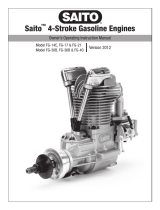Page is loading ...

Part #VT176
Revised 6/14/05
Tech Help
1-800-967-1066
www.vthunder.com
VThunder™ Camshaft Installation
Thank you for choosing V Thunder™ products; we are proud to be your manufacturer of choice.
Please read this instruction sheet carefully before beginning installation.
Installation Notes
• This kit is designed for use on all 1340cc Evolution® engines.
• The installation of this kit may require additional cam shims for proper end play.
• Installation of this kit may void the Harley-Davidson® limited warranty on related components.
This kit is only legal for use on off-road vehicles. This product is not intended for any use that alters
or disables emission devices installed as original equipment and required by law in California or
elsewhere.
• Each kit contains a Cam Gear Assembly and Specification Card.
• When installing any cam more aggressive than stock, the engine must be checked for proper
clearances.
Warning
To prevent accidental starter operation, disconnect battery cables (negative first) before doing any
work on the engine, drive, or electrical system. Gasoline is flammable and fumes are explosive. To
avoid possible personal injury, drain the gasoline in a well ventilated area away from fire or flame.
Drain gasoline into an approved gasoline container only.
Disassembly
Note: If you are using V Thunder® Fast Times™ adjustable pushrods, simply cut out the OE
pushrods and skip step 1.
1. Remove the three rocker covers at each cylinder.
2. Remove pushrods and pushrod covers.
3. Remove the bolts holding the tappet guides to the gear case. Fashion a U-shaped wire from a large
paper clip. Insert the ends into the tappets and tilt the guide and tappets out together.
4. Drill out the rivets and remove ignition outer cover.
5. Remove the two ignition sensor cover screws, the sensor cover, and the gasket.
6. Remove the sensor plate screws and lock washers.
7. Disconnect the sensor plate wires at connection so the sensor plate may be moved.
8. Remove the rotor screw and rotor.
9. Remove gear case cover screws.
10. Tap gear case cover with a soft-faced mallet to loosen and remove gear case cover and gasket.
11. Remove the cam, spacing washer (if so equipped) and thrust washer.
INSTRUCTIONS

Part #VT176
Revised 6/14/05
Tech Help
1-800-967-1066
www.vthunder.com
Inspection
1. Inspect cam gear bushing in gear case cover for pitting, scuffing or grooving. Determine bushing
wear; if damaged or exceeds wear limits shown in engine specifications, replace them.
2. Check needle bearings for damage. Replace if necessary.
3. Check lifter rollers for excessive wear. Repair or replace as necessary. (We recommend replacing
the OE lifters with V Thunder® Velva Touch™ lifter kits or Hy-Rev™ replacement lifters.)
Assembly
Note: Install new gaskets where gaskets were removed during disassembly. Replace camshaft oil
seal in gear case cover.
1. Install cam, omitting cam gear end spacer for the purpose of checking gear mesh. Rotate engine by
hand while sliding the cam gear back and forth through the tapped guide hole in the gear case. Mesh
is correct when no play between gears can be felt and cam gear can be moved back and forth along
the shaft axis with a slight drag. If gear mesh is unsatisfactory, check service manual for proper
selection of pinion gear size to obtain proper tooth clearance for best operation.
2. To establish proper cam gear end play: Install cam gear with thrust washer and spacing washer.
Breather, cam and pinion gears have timing marks which must be aligned. Position and secure new
cover gasket with at least four screws. Measure camshaft end play between cam gear and thrust
washer with thickness gauge through tappet guide hole in gear case. End play should be 0.001-
0.016". If measurement is under/over tolerance, remove the cover and replace the spacing washer
with one giving suitable clearance. Cam gear spacing washers are available in 0.005" increments
from 0.045-0.095" thick.
3. Secure cover using all cover screws. Tighten screws to 90-120 in/lbs torque. After securing cover,
pour about 1/2 pint of engine oil through tappet guide hole over gears to provide initial lubrication.
4. Install tappet guide and tappets.
5. Assemble remainder of gear case and ignition timer. See Ignition System, section 8, in appropriate
service manual.
6. Rotate engine crankshaft so either cylinder has both valves closed. Install rocker covers, pushrods
and pushrod covers at the cylinder where the valves are closed. Tighten bolts alternately in small
increments to allow oil in tappets to bleed off and to avoid damaging pushrods. Consult service
manual for proper torque specifications. Repeat procedure at second cylinder. Due to different cam
base circle sizes with after market cams, we strongly recommend using adjustable pushrods for
proper lifter preload. If you are using V Thunder® Fast Times™ adjustable pushrods with OE
lifters, pushrod adjustment is as follows: Adjust pushrods out to zero lash (no pushrod shake). Turn
out pushrods 3 full turns (18 flats) more and lock jam nuts.
This cam was designed to replace a stock cam without fear of valves hitting pistons. However, some
‘85/’86 engines did not have valve notches in the piston and certain police engines have milled heads.
These engines must be checked. We recommend this inspection or any other subsequent piston
modification be done by a Harley-Davidson ® dealer or experienced machine shop. Put clay, about
1/8" thick, on the piston, in an area where valve would contact piston. Assemble the heads and valve
train, turn the engine by hand. Remove the heads and measure the clay at its thinnest point. If it is not
at least .080" thick, notches should be cut into the piston to obtain that dimension. The depth of the
notches must not exceed 0.135". It is strongly recommended that this practice be followed.
V Thunder™ by COMP Cams®
3406 Democrat Rd.
Memphis, TN 38118
/



